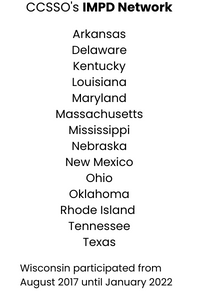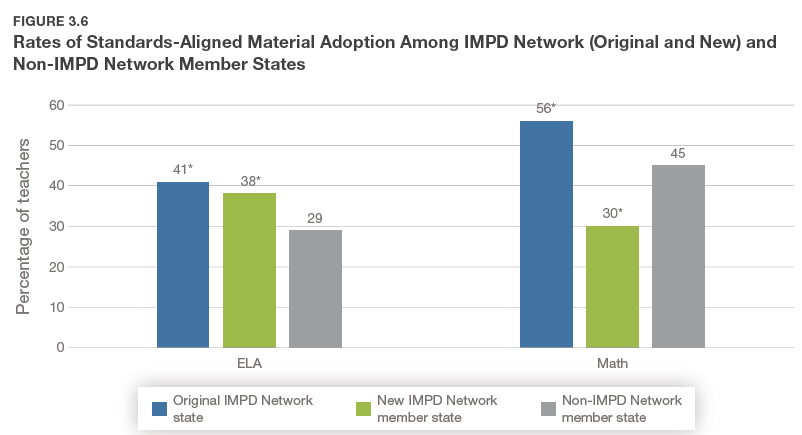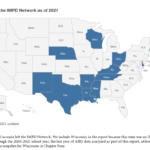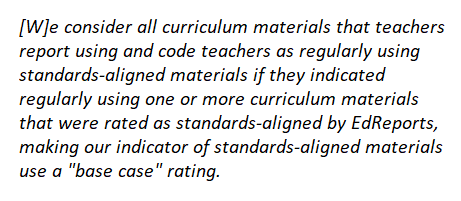
If you have perceived an increase in state control over the adoption of instructional materials, you are not alone. This blog explains the reason for the shift away from districts’ control over the selection and use of instructional materials.
In a recent EdWeek article, education leaders who shaped the standards movement argue “that states should be doing more ‘quality control’ when it comes to instructional materials—signaling which are high-quality and incentivizing and supporting districts to use them.” Citing the findings of a 2022 RAND Corporation study, the architects of the Common Core State Standards argue that states that have implemented 1) a vetting process to identify high-quality instructional materials, and 2) professional learning to support the implementation of those materials, have seen improvement in student achievement. It seems difficult to draw that conclusion based on the findings of the RAND study which, as explained below, draws no connection between specific state policies and student achievement results.
It is noteworthy that the development of the Common Core state standards and the Rand Study referenced above were funded by The Bill & Melinda Gates Foundation and CCSSO and EdReports also receive funding from The Gates Foundation.
The High-Quality Instructional Materials and Professional Development (IMPD) Network
The RAND study analyzed the work of the High-Quality Instructional Materials and Professional Development (IMPD) Network. Formed in 2017, the IMPD Network is a group of 13 states convened by the Council of Chief State School Officers (CCSSO) to promote districts’ adoption and teachers’ use of high-quality instructional materials (HQIM). The IMPD Network initially included 8 states: Delaware, Massachusetts, Mississippi, Nebraska, New Mexico, Rhode Island, Tennessee, and Wisconsin, which dropped out in 2022. Arkansas, Kentucky, Louisiana, Ohio, and Texas had joined by 2020. (Doan, et al. 2022, 7)
Instructional Materials and Professional Development Network (IMPD) Strategies
Pursuant to the CCSSO policy roadmap, the IMPD Network states implement a variety of “signals and incentives” to encourage the adoption, use, and support of HQIMs by districts and teachers. These include:
(1) Signaling the quality of materials: All IMPD network states provide information about the quality of instructional materials to guide districts about the types of materials they should adopt.
Recognizing that states have varying definitions of HQIM, the study focuses on standards alignment as a universal measure of quality. For purposes of this study, the term “standards-aligned curriculum materials” refers to any materials that EdReports has judged as fully meeting the expectations of college-and career-ready standards. (Doan, et al. 2022, xi) In other words, materials counted as HQIMs for purposes of this study are not necessarily aligned to state standards.
Besides identifying state-sanctioned HQIMs, other signals these states are using to encourage districts to adopt HQIM include (a) posting a list of the instructional materials districts are using on the state department of education’s website, and (b) posting guidance/rubrics to facilitate districts’ selection of HQIM. A few of the Network states mandate district adoption of state-adopted instructional materials.
(2) Incentivizing the adoption of HQIM: Most network states also tie funding, including Elementary and Secondary School Emergency Relieve (ESSER) funds, state grants, and competitive funding, to the selection of HQIM. In other words, districts are not eligible for grants unless they agree to use certain state-sanctioned HQIMs. Some IMPD Network states also enter into state contracts with HQIM publishers to lower the price and make it easier for districts to purchase HQIMs.
(3) Providing professional learning aligned to the HQIM: Most IMPD Network states also incentivize districts to purchase HQIMs by providing school/district staff with professional learning aligned to the HQIMs to ensure successful implementation. The states also incentivize districts to select certain professional learning vendors that meet state-adopted criteria.
(4) Engaging with educator preparation programs: IMPD Network states are beginning to work with teacher prep programs to increase focus on using HQIM within classes and clinical experiences. (Doan, et al. 2022, 8-9)
Table A.1. identifies the specific signals and incentives that have been implemented in each of the 13 IMPD states. (Doan, et al. 2022, 91-93). While cloaked in terms of fostering local control (e.g., encouraging, incentivizing), the IMPD Network states’ signals and incentives actually limit districts’ choice of instructional materials.
RAND Report’s Theory of Action and Findings
So have the IMPD signals and incentives worked? The RAND study set out to investigate the extent to which being in the IMPD network predicted districts’ adoption and teachers’ use of standards-aligned materials. The study analyzed teacher survey responses collected through the American Instructional Resources Surveys (AIRS) since 2019. (Doan, et al. 2022, 6)

Comparing the responses of teachers in the 13 IMPD Network states to teachers nationally, the authors conclude that “participation in the IMPD Network was positively linked to the usage of standards-aligned materials,” (Doan, et al. 2022, 86). However, they also acknowledge that there was “a high level of variation across the 13 states in the IMPD Network regarding the adoption of standards-aligned materials” in math (Doan, et al. 2022, 20) and ELA. (Doan, et al. 2022, 23). As illustrated in Figure 3.6:
(1) for ELA, 41% of teachers in the original IMPD Network states and 38% of teachers in the new IMPD Network states reported that their district had adopted at least one standards-aligned material as compared with 29% of teachers in non-IMPD network states.
(2) for math, 56% of teachers in the original IMPD Network states and 30% of teachers in new IMPD Network states reported that their district adopted at least one standards-aligned material as compared to 45% of teachers in non-IMPD states. (Doan, et al. 2022, 28)
The data show that after three years of implementing the IMPD’s signals and incentives, the number of districts that have adopted at least one standards-aligned curriculum has increased by approximately 10 percent.
Report’s Suggestions for State and District Policymakers
The study makes the following suggestions to state and district policymakers:
(1) State networks, like the IMPD Network, have great potential for shifting teaching and learning at scale. The authors acknowledge, however, “We do not know as much about the specific mechanisms by which the IMPD Network has led to shifts across participating states and whether shifts in the usage of standards-aligned materials will be sustained and have clear effects on student achievement, which could be the focus on follow-on research.” (Doan, et al. 2022, 88)
(2) To increase usage of and support for standards-aligned materials in the classroom, focus first on encouraging adoption of standards-aligned materials. The authors repeatedly note that districts’ adoption of standards-aligned materials is a critical precursor to teachers’ use of those materials: “Very few teachers reported that they used a standards-aligned material if they did not report that their school or district had adopted one.” (Doan, et al. 2022, 89)
(3) State requirements likely encourage more adoption of standards-aligned materials, but other levers, such as those increasing buy-in for use of standards-aligned materials among principals and teachers, might also encourage adoption and use. The study highlights the fact that states that mandated district adoption of HQIMs saw an increase in teachers’ use of those materials. However, a few other states, such as Louisiana, Delaware and Nebraska, also saw increases in teachers’ use of standards-aligned materials without mandates. The authors conclude that “absent mandates, much consensus-building, long-term work is necessary to encourage a high rate of usage of standards-aligned materials.”
(4) Encouraging buy-in among principals and teachers regarding the importance of using standards-aligned materials—rather than simply requiring use—could be an effective strategy for encouraging more use of those materials. Suggested principal-focused strategies include (a) professional development to help school leaders promote the implementation of HQIM in their schools, and (b) state-created tools for teacher observations that include consideration of whether teachers use HQIM in their lessons. (Doan, et al. 2022, 89)
(5) Efforts to improve teachers’ understanding of what is standards-aligned and what is not could encourage greater usage of standards-aligned materials. One strategy to improve teacher buy-in and perceived adequacy of their materials was the use of curriculum ambassadors or lead teachers who serve as advocates for the material and support their colleagues in implementing HQIM. (Doan, et al. 2022, 89-90)
(6) School systems leaders must lean into supports for standards-aligned materials to ensure uptake in usage. The report states, “As indicated by our findings, states likely play a large role in the adoption of standards-aligned materials. . . . [S]chool systems themselves likely play the greatest role when it comes to the provision of supports, which, in turn, are connected to higher usage of standards-aligned materials. ” (Doan, et al. 2022, 90)
Our Analysis
In the wake of the 2008 recession, many states loosened the reigns on districts’ selection of instructional materials. Several states abandoned their state adoption process completely; others made the state adoption lists advisory rather than obligatory. Over the last few years, the pendulum has started to swing back and the RAND study explains why. Thirteen states in the CCSSO-led IMPD have implemented policies to wrest control over the selection and use of instructional materials away from districts and teachers with the goal of increasing the quality of materials used in the classrooms. How many more states will join the IMPD Network? Time will tell. The EdWeek article and RAND study cited above certainly aim to encourage participation.
Policymakers and educators agree that using standards-aligned, high-quality materials fuels student achievement. They disagree over who should decide which materials are high quality. The architects of the Common Core and the CCSSO believe states should make that determination. However, local control over the selection and use of instructional materials is a long-held and deeply-rooted belief. To facilitate the achievement of the communal goal while also respecting local control, Learning List provides a range of resources, including online professional development courses, state-specific instructional material alignment reviews, and online Selection Toolkit, that empower districts and educators to select materials that are aligned to their state standards and provide the instruction and supports their students need.
* Doan, Sy, Julia H. Kaufman, Ashley Woo, Andrea Prado Tuma, Melissa Kay Diliberti, and Sabrina Lee. 2022, “How States Are Creating Conditions for Use of High-Quality Instructional Materials in K–12 Classrooms: Findings from the 2021 American Instructional Resources Survey.” https://www.rand.org/pubs/research_reports/RRA134-13.html.

